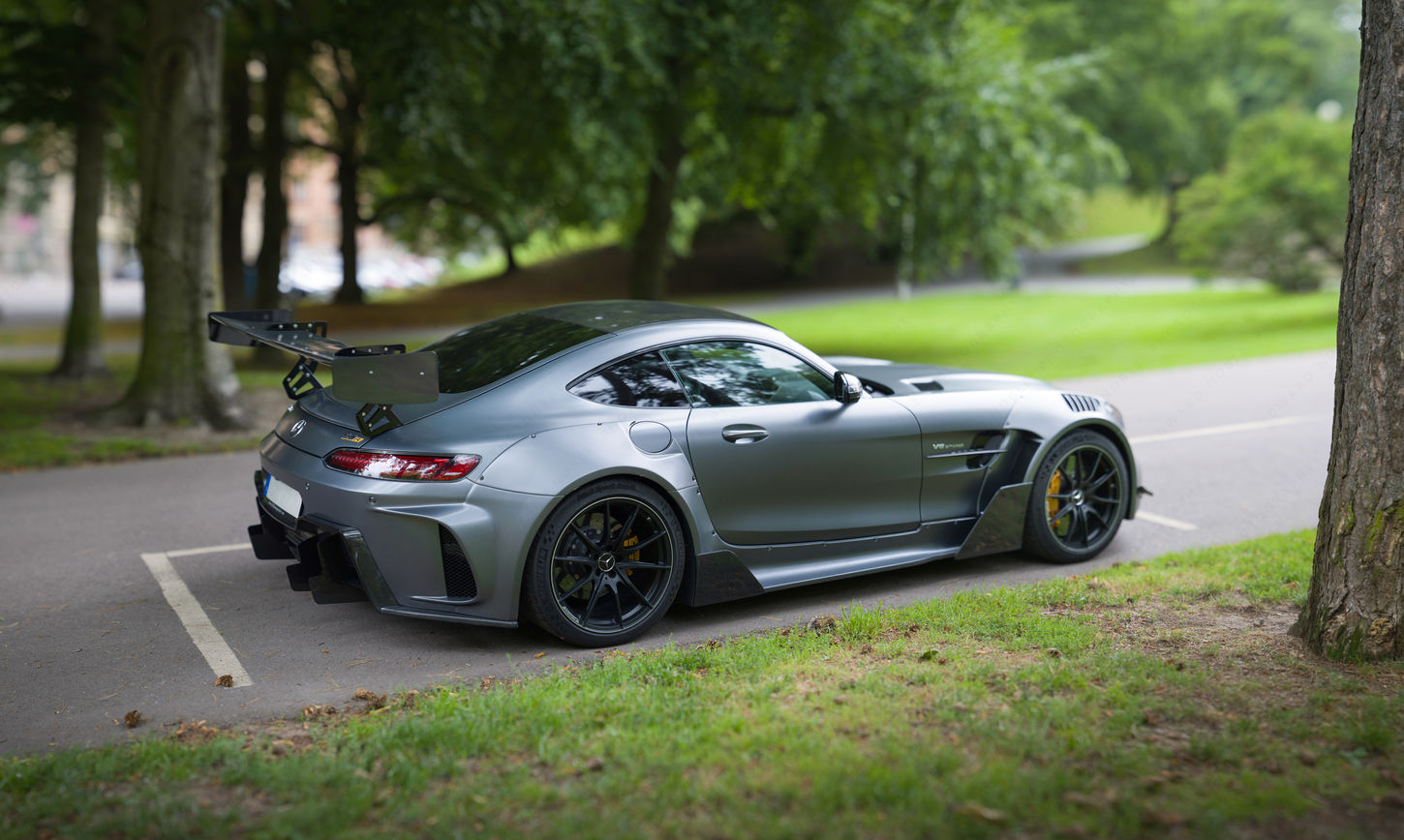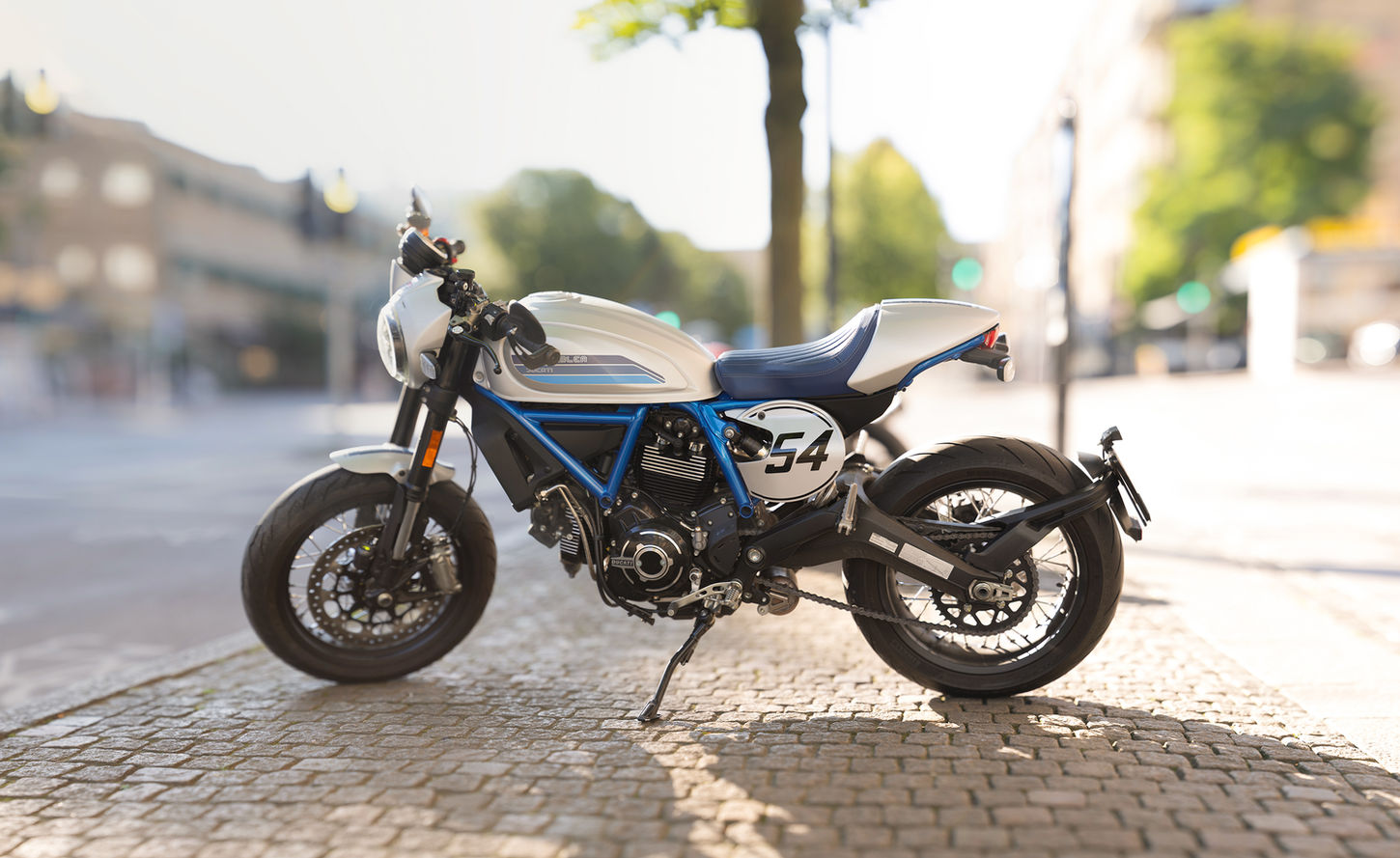Samyang 135mm f/1.8 - Super Light Mega Bokeh
Modern 135mm f/1.8 AF lenses have impressive image quality & AF considering the sheer size of their 'Entrance Pupil'. (that is: How big the max aperture appears through the front of the lens): This massive 75mm* diameter entrance pupil lets in over three times as much light as a 50mm f/1.2 lens. They're great in low-light and provide impressive subject isolation. They just tend to be big, heavy and expensive while retaining high image quality. However, recent advancements in engineering have enabled manufacturers to perform relative miracles in those regards. Samyang's AF 135mm f/1.8 FE is perhaps one the most impressive at doing all three! Weighing only 772g (1.7 lbs), its lighter than the Sony's 85GM, while far out-performing it on image quality, subject isolation and cost.

Sony A1 - 1/320th | f/2 | iso 800
Fast 135mm AF Lenses
Nikon's novelty 'Defocus Control' lens (1995) was the first 135mm f/2.0 AF lens, but only a year later Canon's 135mm f/2.0 L USM demonstrated how sharp these fast tele lenses could be. It held the crown for over 20 years and is still a damn good lens today. However, since they were quite late to the DSLR lens party neither got a redesign.
In 2007 Zeiss built the first f/1.8 135mm (for the Sony Alpha DSLRs). With Sony's first full frame DSLR (A900) coming out a year later, the combo was impressive, even if it weighed a hefty 1,950g (4.3 lbs). The optical performance was superb, but the rendering was the most impressive! For another decade, nobody else tried to make a superfast 135mm lens. Could this have been just too fast and expensive to engineer and sell well?...
In 2017 Sigma decided to take things up a notch. They set a new standard for optical performance with their 135mm f/1.8 DG Art (DSLR lens) and right from the widest aperture. It was even more heavy, but most people agreed that the quality was worth it, and now Nikon and Canon DSLR owners could experience the greatness too. The only problem was that DSLRs were killed by something else that came out in 2017 - The Sony A9.
In 2019 Sony would make the first mirrorless design for the 135mm f/1.8, with their GM model. Keeping the performance, while dropping the weight to under one kilogram (2.2 lbs). Soon, the floodgates on 135mm f/1.8 AF mirrorless lenses would open.
-
2007 - 135/1.8 Zeiss A - 1,210g (2.67 lbs) * First
-
2017 - 135/1.8 Sigma F/EF/SA - 1,255g (2.65 lbs)
-
2019 - 135/1.8 Sony FE - 950g (2.09 lbs) [review]
-
2022 - 135/1.8 Samyang FE - 772g (1.7 lbs)
-
2023 - 135/1.8 Canon RF - 935g (2.06 lbs)
-
2024 - 135/1.8 Nikon Z - 995g (2.19 lbs)
-
2025 - 135/1.8 Viltrox Z/FE - 1,300g (2.87 lbs)
-
2025 - 135/1.4 Sigma L/FE - 1,430g (3.15 lbs) * First [review]
The Sony A9 & Sigma 135mm lens was a formidable combo, in 2017. At a weight of 1,928g (4.25 lbs), it was heavier than the DSLR combo from almost a decade prior (Sony A900 + Zeiss 135 - 1,900g / 4.19 lbs). Two years later, the Sony 135GM lens brought the mirrorless combo down to a more manageable 1,623g (3.58 lbs) while improving image quality and AF performance. The weight alone wasn't as important as its distribution, which concentrated that weight nicely towards the back end. By 2022 the total system weight (on Sony) could be reduced to 1,281g (2.82 lbs) using the Sony A7C and Samyang AF 135mm f/1.8 FE, which was surprisingly cheap too.
In 2025 Viltrox are starting to make a name for themselves by releasing another high performing, great value lens that's also the heaviest version by far. Nikon users can choose between very expensive or very heavy, with no real lightweight options available. Later on in the year, Sigma released their f/1.4 135mm lens, which is a miracle of small and light engineering (for what it is), but it's worth noting that it literally weighs double what this Samyang f/1.8 does.
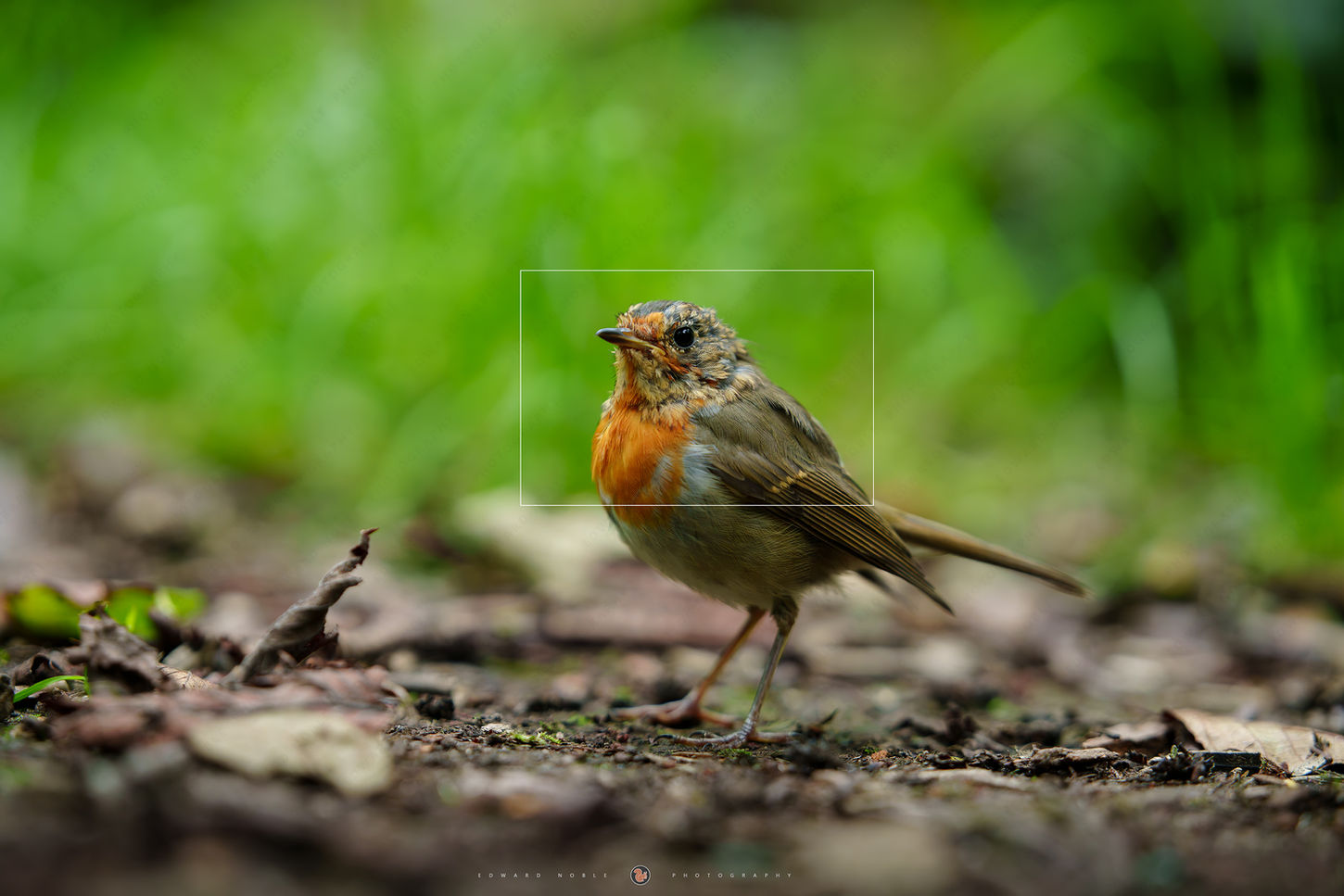
Sony A7CR | f/2.0, 1/160th, iso 2,000 (DxO)
Image Quality
The above crop (3.8x) from the Sony A7CR is a 4 megapixel area that is equivalent to using a 514mm f/7.6 lens (f/6.8 if it was wide open). After reviewing the first few photos taken from the Samyang, I was blown away. Image quality is really sharp from wide open and right into the corners (just like the Sony 135GM). Another similarity to the Sony lens is the minimum focus distance (69cm / 27 inches). This close focus combined with the extremely high image quality makes it a great option for wildlife, products and even moderate macros (as well as portraits and landscapes). Small animals like mice can pretty much fill the frame and it's fast enough to capture them with limited forest floor lighting too.
I can imagine many considering a fast 135mm lens like this and choosing something like the Sony FE 70-200mm f/2.8 GM II instead, due to the versatility of a zoom. I see it the other way around, however. The Samyang is lighter still, a tiny fraction of the cost (£2,500) and over a stop faster. On this camera (A1) I can crop to 23mp for a 200mm f/2.7 equivalent, or 11mp for a 300mm f/4 equivalent. If you think that resolution doesn't sound enough, note the above image is only 0.5mp, or check out the 1mp images at the end of this page. If you're prepared to stitch just 9 images together from the Samyang you can get a 200mp 70mm f/0.93 result (see Bokeh Pano section below). That's significantly better image quality, three stops faster than the 70-200mm lens and for one quarter of the price!
The next image shows a before and after I did some processing. The image on the left is an uncropped raw file.
Sony A1 | f/2.0, 1/160th, iso 10,000

Build
Unfortunately I got a chance to test the build quality first hand, under stress. I had put the camera (with the Samyang 135mm) back in my bag, but stupidly forgot to close the zip. As I was walking along an asphalt path the camera fell out of my backpack and bounced off the ground. The lens hood and cap took the brunt of the impact and although it cracked in a few places it held together well enough that it still attaches fine. It still clicks into place (both ways). The lens glass looks unharmed and works flawlessly. The camera (A1) got a small scrape near the card door, but is also otherwise fine. Considering the impact I expected the lens to be totalled, but to my surprise it was largely unharmed. It's just one anecdotal experience of course and perhaps I was quite lucky, but I think the low weight of both camera and lens helped with the build quality. Anyway, wanted to share this story as not many people will be careless enough to find this out.
I treat all my lenses carefully and the Sony 135GM had never been dropped, but it's front assembly (the "plastic" ring that holds the cap and hood) fell off and needed a €300 repair. Since it was not under warranty I had to pay that myself. I was reluctant to do that, not knowing if the price would be even more insane, so I ended not using the lens for 2 years. It is a shockingly bad design that allows a tiny plastic pin to render the entire lens unusable if it fails, and will do so under normal use. I think it was stressed by moving around in my backpack while the hood was attached (reversed). The Samyang lens has proven itself to have no such Achilles heel.
Bokeh Panos
This focal length can feel a bit restrictive, so if you want a winder angle with the dreamy shalllow depth of field you can use the bokeh panoramas technique (A.K.A. "Brenizer Method"). Just shoot a bunch of images with locked settings and stitch them together. I have been shooting these for 15 years now, they're much easier to shoot on mirrorless cameras, with lighter lenses like this.

Bokeh Panos: between 40 -100 images each
Equivalent: 26mm f/0.35 - 34mm f/0.46
Holding this lens up (with the Sony A1) and shooting 100+ images (without a tripod) really made me appreciate the lower weight. I remember shooting the technique with the Sigma version a few years ago and my arms would really start to hurt towards the end of longer batches. 400g (14oz) might not sound like a huge weight saving, but here I get no pain at all. Even compared to the Sony lens the weight savings are more modest, but still noticeable. By the end of a day I had noticeably less shoulder strain from the bag too.
Compared
The length, shape and size of these two Sony FE mount lenses is very close. I initially wondered whether the Samyang might be a clone of Sony's optical design too, but diving through the specs online suggests this is not the case.

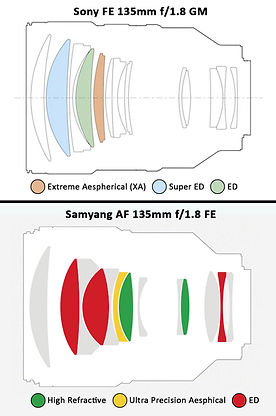
Total Weight
Mirrorless cameras can be quite a bit lighter than DSLR's, but that advantage can disappear once you add a lens. This is especially true with fast and very high quality optics, but some are managing to make lighter lenses while retaining very high image quality. Here are some total weights for these 135mm f/1.8 lenses including a full frame camera:
Nikon FF camera + Nikon Z 135mm f/1.8:
-
Low - Nikon Z5 - 1,670g (3.68 lbs)
-
Mid - Nikon Z6II - 1,700g (3.74 lbs)
-
High - Nikon Z8 - 1,905g (4.2 lbs)
Nikon didn't really get the memo that mirrorless cameras can be light. It wouldn't be so bad if their battery life didn't suck so badly, but they make up for it somewhat with decent features. This is especially true of their Z8 model. Which is a great camera, but it's heavier than most DLSRs and it's not even their pro sized body... ouch!!
Canon FF camera + Canon RF 135mm f/1.8 L IS USM:
-
Low - Canon R8 - 1,396g (3.07 lbs)
-
Mid - Canon R6II - 1,605g (3.53 lbs)
-
High - Canon R5 - 1,673g (3.69 lbs)
Canon now have some nice and light mirrorless cameras. Although their lightest full frame one doesn't have stabilization, the lens does, so it scrapes through the minimum requirements here. On the high-end there is no stacked high resolution option yet, but the R5 is still a great pro mirrorless option. It's as light Nikon's lowest end camera with 135mm lens, which is really impressive.
Sony FF camera + Samyang FE 135mm f/1.8:
-
Vid - Sony ZV-E1 - 1,255g (2.77 lbs)
-
Low - Sony A7CR - 1,287g (2.82 lbs)
-
Mid - Sony A7IV - 1,431g (3.15 lbs)
-
High - Sony A1 - 1,509g (3.33 lbs)
Panasonic don't have a mirrorless 135mm f/1.8 option. Although there is a L mount version of the Sigma DSLR lens a combo with the S5 II X would weigh: 1,960g (4.32 lbs). That's more than many DSLR options, but is mostly the fault of the DSLR lens.
If this sea of numbers is overwhelming to you too, perhaps you'll appreciate it in graph form, with some DSLR comparisons...

Sony mirrorless cameras are pretty light for what they are, but the main advantage they have on this comparison chart comes from the Samyang lens rather than the cameras themselves. The ZV-E1 may be really close in weight to the Canon R8, while not having a viewfinder and only a 12mp resolution, but... It's essentially a lightweight A7S III with an AI chip for half the price! Unlike the Canon it does have IBIS and its battery life is considerably better.
Sony options are often cheaper than Nikon and Canon equivalents (apart from the A1), but the price and weight dynamic goes into overdrive with this Samyang lens. Sony have an abundant selection of light, full frame camera bodies with great battery life and IBIS (at various budgets), but given they also have the biggest selection of 1st and 3rd party lenses by far there's a lot to like.

Sony A7CR | f/2.0, 1/160th, iso 100
Cost
If you thought the weight section was impressive, buckle up for this one because the Samyang's value is off the charts... well, kinda firmly inside them, but hopefully you get the point. It's worth noting here that the Samyang is on offer, although it's not even two years old, so I'm not quite sure why. Perhaps the focal length is not so versatile for most people, or perhaps the low price is making people wonder what's wrong with it.
The Samyang is cheaper than even their own 85mm f/1.4 lens, yes the new mkII one! Of course it's cheaper than everyone elses 85mm f/1.4 lenses too. To me that's crazy because the entrance pupil on the 135mm f/1.8 is noticeably bigger than an 85mm f/1.2, while providing far better image quality too. This is hands down the best lens for the price that I have ever seen!
Unfortunately for other mirrorless platforms the Samsung AF 135mm f/1.8 lens is currently only made in the Sony FE mount. This may change though and Viltrox may soon get a similar option, so if you're on Canon or Nikon and looking for a budget and/or lightweight 135mm f/1.8 keep your fingers crossed...
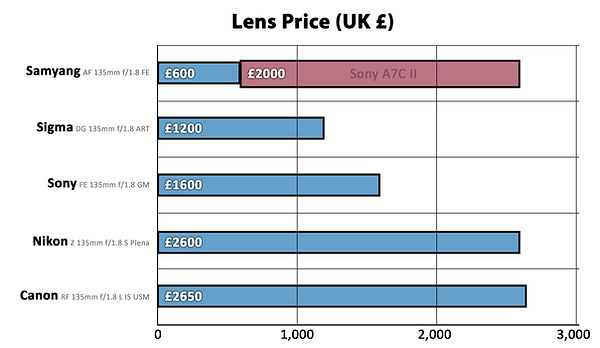
Being able to buy FOUR Samyang 135mm f/1.8 lenses and several official Sony batteries for the price of ONE Nikon lens just sounds obscure, so think about it this way... For the price of either the Nikon or Canon version you can get the Samyang lens and a Sony A7C II camera (new). One of the lightest full frame setups and still feature packed too (33mp sensor, 7 stops of IBIS, AI subject recognition, 4k 60fps 10bit video, 10fps, 7k oversampling, human & animal eye-AF in stills and video, 530 shot battery life). That's just insane!!
Another interesting comparison is if you look at the Canon RF 135mm lens on the R5 body. That combo is very close in cost compared to the Samyang and Sony A1. Personally I feel like the A1 is rather over priced right now, but it would provide an even faster experience, with a stacked sensor. It would also weigh less (164g / 5.8oz), thanks to the lens, and have nearly double the battery life.
Conclusion
If you read the rest of the review you'll know that I am blown away by this lens. When I say it's an absolutely crazy bargain, that's not a backhanded way of saying its good, but has problems. It really doesn't have much in the way of down sides (at least for me). It has the best image quality of pretty much any lens and an amazing minimum focus distance (albeit the same as the Sony 135GM). I honestly don't know how they can make a lens with this performance so cheap and light...
Sure, some people miss the AF switch and aperture ring, but I never use them, so it's actually another plus for me that they don't get knocked by mistake. The only slight down sides from my perspective are that the AF is a bit slower than the Sony 135GM (not by much) and it makes a tiny bit more noise when focusing. It could be that the A1 and A9 is making up for some of the performance loss here. I really would like to to test it on something like the A7C II or A7R to really take advantage of the low weight of the combo. If I do I will report back soon...
Images
Finally, I will end with a gallery of large single image examples from the lens...

Bonus Squirrels
My current squirrel obsession means you will see lots of these fluffy-tailed tree-rodents around here. There are especially many here, even after I lost many images from this period (due to losing a laptop drive), because I took this lens everywhere. This lens is so light that I even take it on holiday to Switzerland. Images of the central European black coloured Eurasian squirrel here are the only images I have left from that photoshoot, unfortunately. Don't be an idiot like me. Back up your photos!




